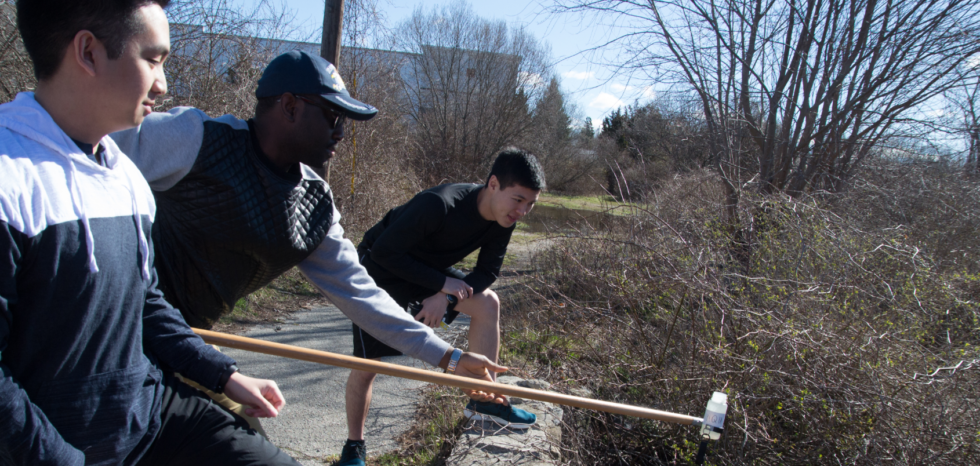OCEAN
Improve Water Quality

Water falls from the sky as a gift, it is free, and ready to drink. But upon arrival it interacts with the environment that mankind has created. Rooftops, driveways, expansive lawns, roads, the list keeps going on, but all of this has the chance to impair water quality and lead to storm water runoff or combined sewage overflows that wreak havoc on coastal water quality. Our Ocean Program exists to improve coastal water quality and starts with every drop that lands on the island and the path it takes to the ocean. This includes watersheds, rivers, streams, brooks, ponds and coastal waterways, and is part of a program that include regular water quality monitoring, timely identification of pollution sources, and effective remediation plans.
Overview of active efforts
Water Quality Monitoring - Every Thursday morning the community works together to collect water samples at sixteen locations that are tested for Enterococci (indicator of warm-blooded animal waste) to determine if bacteria levels are safe for swimming. The locations are popular swimming and surfing locations, and are not necessarily tested by the Department of Health. This program keeps a laser focus on the importance of water quality year-round, and how our action on lands impacts the health of our ocean. To learn more on how to get involved, please visit our community scientist page.
Education and Outreach – Our education and outreach activities are aligned with our community scientist efforts so that a hands-on student-led experience can have the greatest chance of fostering environmentally responsible behaviors and promoting stewardship in our community via action. For complete information about education and outreach opportunities, please visit our education page.
Analytics and Reporting – Data becomes information and information becomes knowledge that informs our decision making to improve water quality. With over fourteen years of water quality results we have amassed an incredible data set that empowers our organization. All of our data is available for the public and our annual Ocean report can be found on our reports page.
Advocacy – Our main goal is to bring about systemic change is to connect the community with the environment, educating, inspiring, and empowering to foster environmentally responsible behaviors. However, some forms of water quality problems require advocacy and policy. For complete information please visit our advocacy action page.
Weekly Water Sampling Results
- The map below displays the 16 locations where we take weekly water samples for bacterial analysis.
- There are two layers: the current week’s results and the annual geometric mean* at each location.
- To use the map, click the icon in the top left corner to display the legend. Check the layer you want to see. Make sure only one layer is checked at a time. The layer that is checked is the layer that is visible on the map.
- Each tested location is represented by a colored dot. The colors represent the levels of bacteria. Green indicates safe levels of bacteria (<60 CFUs/100ml) and red indicates hazardous levels of bacteria (60+ CFUs/100ml ).
- To see the specific data values for each location, click on that location’s dot.
- Bacteria levels are continuously in flux. Therefore, our weekly results represent a snapshot in time, whereas the geometric mean better indicates the typical bacteria level at each location.
More Information About our Weekly Water Testing
Bacterial Analysis:
The water samples are tested for Enterococci bacteria at the RI Department of Health laboratory. Enterococci are bacteria that live inside humans and other animals. Although these bacteria are not harmful to humans, their presence indicates that fecal matter, which poses a risk to human health, is also present in the water. Fecal matter contains bacteria and viruses that can cause humans to get sick if they come in contact with them through recreating in contaminated water or consuming contaminated seafood.
Sources of Bacteria:
There are many sources of Enterococci. Most Enterococci in water comes from human and other animal waste, while a smaller portion can come from non-fecal sources such as plants, soil, and other sediment. Fecal matter can enter waterways from leaking septic systems, stormwater runoff, effluent from wastewater treatment plants, combined sewer overflow events, sewage released from recreational boats, wildlife waste, improperly disposed domestic animal waste, and runoff from manure on agricultural landscapes (EPA).
*Geometric Mean:
Long-term water quality is best understood by calculating the geometric mean. The geometric mean is similar to an average, but it is more accurate for large sets of data over a long period of time such as our weekly water tests since 2008. This is because the geometric mean represents the typical value of a set of numbers and is less influenced by outliers like a very high value one week. For swimming locations, the Rhode Island standard for results of the Enterococci test is to compute the geometric mean for at least five samples. The action standard is 32 CFUs per 100ml for a geometric mean. Our weekly sampling does not result in 5 samples per month, so the geometric mean is applied in a quarterly manner for each season. In addition, we also calculate an overall geometric mean for all the samples we have taken at each location since we began sampling there.
If you become ill after swimming in the ocean, contact the Rhode Island Department of Health (401) 222-5960. Reporting your illness is just as important as collecting the data to share the water quality.
RIDOH map of sampling locations across the state
Statistics
Since our first water sample collected in September 2006 through the end of 2021, the community has worked hard to improve water quality.
41 7,198 619
monitoring locations samples collected OCEAN volunteers
Get involved, volunteer, and become a community scientist!
There are many ways to get involved with our efforts to improve coastal water quality, along with our other programs and project. Please visit our community scientist page.

